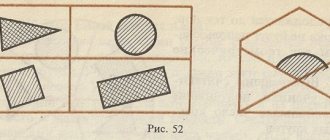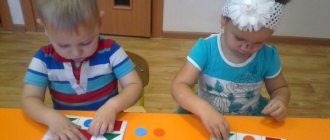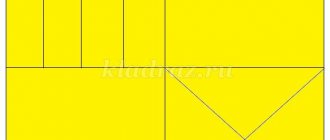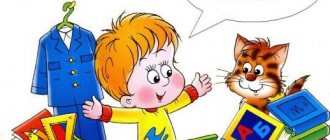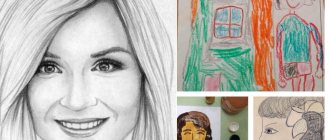Why teach a small child geometric shapes? Surely, many parents do not even think about this issue, simply paying tribute to fashion and teaching their child mathematics almost from birth. Meanwhile, geometric figures for children and their timely study play a big role in the knowledge of the environment, introducing them to one of the main properties of objects - shape. This is necessary for the development of logical thinking, spatial concepts, and improvement of mathematical abilities. That’s why it’s important to start familiarizing yourself with geometric shapes as early as possible, reinforcing children’s knowledge with exciting tasks in everyday life.
What should a child know about geometric shapes?
Important: Geometric figures are generally accepted standards, measures of the shape of objects. Therefore, familiarizing a child with forms at home should not take place separately, but in the system of sensory (sensory) education. The baby will best remember the shape when he simultaneously examines the color, size, and purpose of the object, since in a variety of activities knowledge is actively used and is better remembered.
- Experts say that purposefully teaching a child geometric shapes at home should begin in the third year of life. At this time, children gain motor and tactile experience in exploring the world around them. They know how to speak, are distinguished by their curiosity and desire to explore everything, and strive for new things. That is why, for the further formation of children’s knowledge, work is needed to replenish their ideas about geometric shapes: circle, square, triangle. In an exciting game (not on purpose!) the baby gets acquainted with a ball (ball), cube (cube).
- Four- to five-year-old children recognize rectangular and oval shapes in addition to triangular, square, and round shapes. It is believed that at the age of 5, children have already mastered geometry, so by the next age stage they should clearly name a circle, oval, triangle, square, rhombus, distinguish them and find them around them. Preschoolers should be able to analyze and generalize the shape of objects, noting basic properties, and even solve logical problems by comparing shapes. For example, in the popular game “What are the similarities and differences between a circle and a square, a square and a rectangle, a circle and an oval?”
- Older preschool children already know the names of all figures well; they are introduced to new ones: planar (polygon, trapezoid) and volumetric (sphere, cube, cylinder and cone). For school education, children need to learn how to divide and assemble shapes in different ways (cutting and folding), solve problems - puzzles, for example, “Do you know how to make a square, rectangle, triangle from two parts?”, “How many squares (circles, rectangles) ) on the image?".
We name geometric shapes always and everywhere
If you come across any figure while playing or reading books, be sure to draw your baby’s attention to it and name it (“Look, the ball looks like a circle, and the cube looks like a square”). Even if it seems to you that the child is unlikely to remember the names of the figures, say them anyway, and they will definitely be imprinted in his head. You can do this for up to a year. At first, point out only the basic shapes (square, circle, triangle), then, when you understand that the baby has mastered them, begin to study other shapes.
Learning geometric shapes with kids: main rules
Important: How to teach your child to name and distinguish geometric shapes easily and quickly! To do this you need to adhere to certain rules. With chaotic, inconsistent learning, the baby may confuse the figures and not see their similarities and differences.
- Teachers insist that when teaching at home, systematicity, consistency, and accessibility should be the main rules. There is no need to torture yourself and your child with any abstruse tasks and manuals; it is enough to use educational books, toys (construction sets, blocks, cars, doll dishes) and familiar surroundings (furniture, household items, dishes).
- Acquaintance with new figures must be carried out through research activities: invite the baby to feel, trace the outline with a finger, “draw” in the air, put the figures together, roll, stick into holes.
- A child will quickly master new material if he practically interacts with it in games, creative activities, looking at and reading books, and everyday activities. For example, when introducing a square to a baby, you can ask him to find square objects in the environment: a seat next to a highchair, a handkerchief, the face of a cube, a napkin. While walking, ask what shape is the bench in the park, the wall of the house, mom’s bag, the ball that the older kids play with. At the same time, the adult himself clearly and clearly names all the geometric shapes that the baby encounters.
- It’s good if, when teaching, adults use rhymes, fairy tales, riddles, and cartoons, the heroes of which are geometric figures. You can not only read them, but also draw to the rhythm of the verse. These techniques will make learning fun and help activate the processes of attention, thinking, and speech.
Riddles in verse
I have no corners and I look like a saucer, a plate and a lid, a ring and a wheel. Who am I, friends? Call me (circle).
He has been a friend of mine for a long time, every angle in him is straight. All four sides are the same length. I'm glad to introduce him to you. What's his name? (square).
Look at the figure and draw in the album, three corners, three sides, connect them together. The result was not a square, but a beautiful (triangle).
There is such a circle - a very strange appearance. The circle became flattened, it suddenly turned out (an oval).
We stretched out the square and presented it to the eye. Who did he look like or something very similar to? Neither a brick nor a triangle - it became a square (rectangle).
Fairy tale “Two Brothers” (an adult draws to the rhythm of the verse)
A long time ago, in a dark forest, in a figurative hut, there lived two brothers, two squares. And they were twins. See for yourself: See in the picture - each one has 4 sides, 4 corners and 4 vertices. Once I was walking around the first square between the bushes, knocking on the path with four corners. And the animals say: “Who is this? The first square or its brother, the second square? How similar they are! Remember in the picture: 4 sides, 4 corners and 4 vertices. The square was tired of being confused with his brother, and he decided to change, to turn into another figure. He took scissors and cut off four corners for himself. It turned into a circle and rolled along the path. And now the brothers live a wonderful life, it is now difficult to confuse the brothers: One rolls along the paths, the other walks on four corners - four legs. Two brothers are still friends - a circle with a square!
Important: Children’s perception of geometric shapes is completely different from that of adults. For example, an adult sees objects according to their shapes (a pan is a cylinder, a window is a rectangle). The child, on the contrary, first objectifies the shape (a square is a kite, a triangle is the roof of a house, a circle is a ball, several circles are glasses, beads). With proper training, he begins to abstract from objects and perceive a familiar figure in the environment, for example, a glass as a cylinder (cylindrical in shape), a roof as a triangle (triangular in shape), a ball as a ball (round in shape).
We glue
You can use geometric shapes in appliqué classes from the very first lesson. When a baby is just getting acquainted with glue (in my opinion, familiarization goes well between the ages of 1 year and 2-3 months), he is more interested in the gluing process itself than in creating some kind of composition. Therefore, you should not create complex pictures in the first applications with your baby; start simply by chaotically gluing pieces of paper onto a piece of paper, or even better, by chaotically gluing geometric shapes! While the baby enthusiastically smears the figurine with glue (with your help) and places it on a piece of paper, you tell him what it is called. With such a game, all the names fit very well in the baby’s head, one might say, they “stick” firmly.
When the baby can already glue applique elements to given places (from about 1.5 years old), you can try to create a simple composition.
You can also use various ready-made aids in your classes, for example:
- School of the Seven Dwarfs 1+. Shape, color (Ozon, My-shop)
- Educational stickers for kids. Form (Ozon, My-shop)
- Wonderful stickers. Fun geometry (Ozon, My-shop)
Playing with geometric shapes!
Teachers remind that preschoolers receive basic knowledge about geometric shapes in kindergarten, and home activities are aimed at consolidating what they are learning. Therefore, the best way to do this at home is to play as the main activity for children. It is in the game that unobtrusively, easily and quickly the child will learn all the names of the figures, learn to compare and distinguish them. Among educational games for teaching geometric shapes, board games take precedence. They can be played in the evenings, during family leisure, or made part of any home activity or entertainment.
"What's Hidden"
The classic game is understandable and accessible even to a two-year-old child. An adult lays out images of familiar shapes in front of the child: a circle, a square, a triangle. Since there must be at least five cards, figures of different colors and sizes are used for the number, for example, two squares - large and small, two triangles - blue and yellow, one circle. Consider them with your child, discuss them, make sure that he understands what figures are in front of him and can name them correctly. Then the baby closes his eyes, the adult hides one of the figures and asks what is hidden. With age, the number of figures increases, new ones are added to the old ones.
"In one word"
The game “geometric shapes” is aimed at developing in children a generalization of similar shapes. An adult needs to prepare circles, squares and triangles of different sizes and colors. The preschooler must distribute the presented figures into groups, regardless of color and size, and name them with a general word, for example, all squares. Alternatively, you can make the tasks more difficult by offering to group shapes only by color or size.
"Wonderful bag"
Games like the “wonderful bag” are well known to children of kindergarten age. They are useful in that they give an idea of the contours of objects, teach examination by touch and exercise in distinguishing shapes. An adult prepares a bag with objects of different shapes, for example, a cube, a ball, a ball, a brick, a conical pyramid. The player examines them and names the shape of the toy he wants to get. To complicate the task, older children are asked to find a specific shape, for example, “Find a round toy.”
"Magic glasses"
Improvised glasses are pre-prepared from thick paper of various shapes: round, square. The game is interesting to all children, it helps expand their understanding of geometric shapes and find objects of a certain shape in the surrounding space. For example, a child puts on round glasses and looks for everything round around him: a plate, the bottom of a vase, a lampshade of a chandelier, a carpet, grandma’s glasses. For each correct selection, the player is awarded a chip and then receives an incentive prize at the end of the game.
"Patches - patches"
For a lesson on consolidating ideas about geometric shapes, you need a selection of pictures depicting various objects that have “holes” - unpainted places of different shapes, for example, a dress has a round hole, a boot has a square one. Among the different “patches” the child chooses the one he needs and connects it to the object. It will be interesting if an adult himself prepares images for the game, for example, cuts things out of paper (sweater, skirt, trousers, boots, hat). As an option for playing “patches - patches”, you can purchase a didactic game of “Velcro”, which are very similar in rules and content
"What's Broken"
This task will help teach children to notice what form is missing in the depicted object and develop attention. For the game you can use pictures, applique from cut out parts, building material. The main thing is that the object must consist of parts of a geometric shape. For example, an adult lays out a “house” applique, where the details are a triangle - a roof, a rectangle - a wall, a square - a window, a small rectangle - a door, a circle - a window in the attic, a quadrangle - a pipe. The child carefully examines the image and closes his eyes, the adult removes any detail, mixing it with any others. You need to guess what is broken at the house and “fix it” by finding the missing part. In the future, you can complicate the task by not immediately adding a certain form or by removing two forms at the same time. If this is a drawn image, then the child draws in the missing details, for example, a circle is a wheel on a car, rectangles are windows on a turret.
"Game with sticks"
An interesting task for middle and older preschoolers, which simultaneously develops motor skills and the ability to compose geometric shapes. If there are no counting sticks, you can use matches or toothpicks, prepare them in advance, cut off the sulfur head or sharp ends so that the baby does not get hurt. Such a task can be carried out in the form of a competition during family leisure time, “who can make a figure the fastest?”, “Who has the most complex figure?” Then reward the winner with a prize. At some point it must become a child. An adult, for example, can note his original solution or carefully and neatly laid out figure.
“What was useful to the artist in the painting”
For older preschoolers, you can use an original task of looking at pictures, which not only reinforces the names of the figures, but also develops visual perception and the ability to see different shapes in an unusual environment. The adult selects illustrations of appropriate content, which the artist draws using geometric shapes. Then he invites the preschooler to look at the picture and find familiar shapes. If any of them are still unfamiliar to the preschooler, be sure to pay attention to them and tell them what they are called and what objects are similar to them. To complicate the game, you can count how many geometric shapes were needed to depict the picture.
"Geometric Lotto"
A classic task to familiarize children with geometric shapes teaches them to compare the shape of an object with a geometric figure and select images based on a standard. To create a competitive moment that is interesting for children, it is better to play with the whole family. The rule is classic: on large cards there are images of different shapes, for example, an oval, a circle, a triangle. The presenter says the name of the item on a small card, for example, apple, cucumber, scarf, TV. Players look for the shape of the named item on their card and cover it with the corresponding picture. The player who quickly and correctly closes the card wins.
"Geometric mosaic"
This educational game will help children consolidate their understanding of geometric shapes. In addition, it will teach preschool children to transform them, focusing on a standard (sample), and will help creative imagination. The rules of the game are simple and accessible to children of any age; for older ones, the number of details increases and the plots become more complex. Players must assemble some objects from several geometric shapes. For kids, these can be houses of different sizes and configurations, cars, turrets, bridges, the sun, flowers, patterns; for older children - figurines of fairy-tale or cartoon characters, plot pictures: a vase with flowers, a street, a road, a carpet, animals, people of different professions. Be sure to note the creativity of the preschool child and praise him. Perhaps leave the posted picture for a while to show all your loved ones. The main thing is that such educational mosaics can be purchased in a special store, or you can make them yourself, similar to Montessori toys.
Let's play geometric lotto
With the help of lotto you can study anything: colors, geometric shapes, vegetables, animals, etc. And geometric lotto is also quite easy to make yourself: on a sheet of paper or cardboard we draw or print two identical sets of shapes, one of which we cut into cards. Everything is ready, you can play. Our lotto templates for learning geometric shapes can be used.
For the first lessons with your baby, it is better to use lotto, which has only 3-4 figures. When your child masters this game well, gradually complicate the task. It is also useful for the first time to make all the figures on the playing field the same color and size. In this case, the child will be guided by only one sign - shape, while other characteristics will neither distract nor prompt him.
You can place both cards with images of figures and three-dimensional figures on the playing field. Dienesh blocks (Ozon, KoroBoom), figures from a sorter, and insert frames are well suited for this purpose.
Well, the easiest option is to purchase a ready-made lotto with geometric shapes.
Learning forms using Doman cards
In fact, I believe that this method of studying forms is the most effective. If you study using Doman cards, your child will very quickly remember all the figures, and you will spend a minimum of effort on it. However, it should be noted that in order for the knowledge gained from Doman’s cards to be deposited in the baby’s head, it needs to be consolidated through other games (see above). Otherwise, the child will quickly forget everything you showed him. Therefore, I recommend starting to look at Doman cards with geometric shapes at about the age of 1 year, since at this time the baby becomes interested in sorters, insert frames, drawing, appliqué, etc. And, having studied the forms from the pictures, he will be able to use the acquired knowledge in these games. By the way, you can buy cards “Geometric Shapes” HERE.
You can read about our experience of studying figures using Doman cards here.
